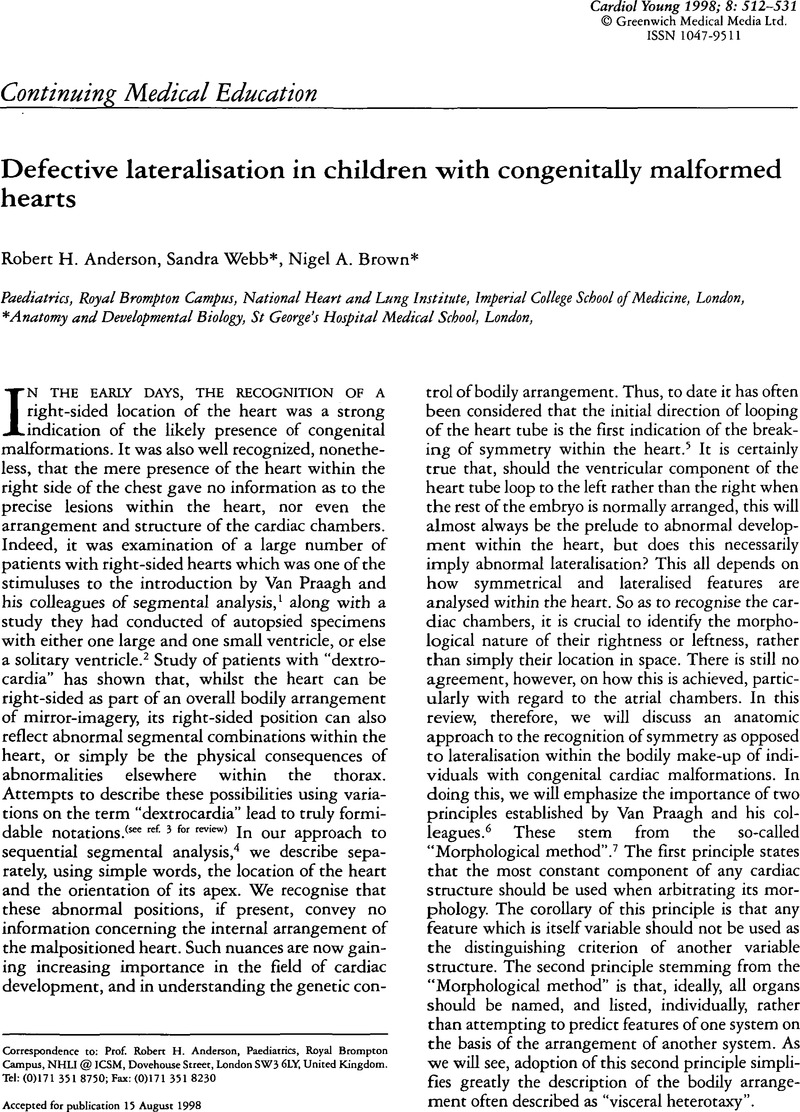Crossref Citations
This article has been cited by the following publications. This list is generated based on data provided by Crossref.
Anderson, Robert H
Webb, Sandra
and
Brown, Nigel A
1998.
Morphologic analysis of animal models of congenital heart disease.
Progress in Pediatric Cardiology,
Vol. 9,
Issue. 3,
p.
139.
Rinne, Katy
Smith, Audrey
and
Ho, Siew Yen
1999.
A unique case of ventricular isomerism?.
Cardiology in the Young,
Vol. 9,
Issue. 6,
p.
606.
Capdevila, Javier
and
Belmonte, Juan Carlos Izpisúa
2000.
Knowing left from right: the molecular basis of laterality defects.
Molecular Medicine Today,
Vol. 6,
Issue. 3,
p.
112.
Anderson, Robert H.
2000.
Atrial structure in the presence of visceral heterotaxy.
Cardiology in the Young,
Vol. 10,
Issue. 4,
p.
299.
Srivastava, Deepak
2000.
Congenital Heart Defects.
Circulation Research,
Vol. 86,
Issue. 9,
p.
917.
Gerlis, L. M.
Durà-Vilà, G.
and
Ho, S. Y.
2000.
Isomeric arrangement of the left atrial appendages and visceral heterotaxy: two atypical cases..
Cardiology in the Young,
Vol. 10,
Issue. 2,
p.
140.
Rinne, Katy
Smith, Audrey
and
Hot, Siew Yen
2000.
A unique case of ventricular isomerism?.
Cardiology in the Young,
Vol. 10,
Issue. 1,
p.
42.
Buheitel, G.
Singer, H.
von Bernuth, G.
Kramer, H. H.
Apitz, J.
Schmaltz, A. A.
Lang, D.
Bürsch, J. H.
Kienast, W.
Schille, R.
and
Schneider, P.
2001.
Pädiatrie.
p.
1030.
Lamers, Wouter H.
and
Moorman, Antoon F.M.
2002.
Cardiac Septation.
Circulation Research,
Vol. 91,
Issue. 2,
p.
93.
Miraldi, Fabio
di Gioia, Cira R.T
Proietti, Piero
De Santis, Marcello
d'Amati, Giulia
and
Gallo, Pietro
2002.
Cardinal vein isomerism.
Cardiovascular Pathology,
Vol. 11,
Issue. 3,
p.
149.
Smevik, B.
and
Stake, G.
2002.
Radiological Imaging of the Neonatal Chest.
p.
111.
Kuehl, Karen S.
and
Loffredo, Christopher
2002.
Risk factors for heart disease associated with abnormal sidedness.
Teratology,
Vol. 66,
Issue. 5,
p.
242.
2003.
The Natural and Modifed History of Congenital Heart Disease.
p.
601.
von Bernuth, G.
Apitz, J.
Schmaltz, A. A.
Lang, D.
Bürsch, J. H.
and
Singer, H.
2003.
Pädiatrie.
p.
1123.
Raman, R.
Al‐Ali, S.Y.
Poole, C.A.
Dawson, B.V.
Carman, J.B.
and
Calder, L.
2003.
Isomerism of the right atrial appendages: Clinical, anatomical, and microscopic study of a long‐surviving case with asplenia and ciliary abnormalities.
Clinical Anatomy,
Vol. 16,
Issue. 3,
p.
269.
Bonnet, D.
2003.
Génétique des cardiopathies congénitales chez l’homme.
Archives de Pédiatrie,
Vol. 10,
Issue. 7,
p.
635.
Männer, Jörg
2004.
On rotation, torsion, lateralization, and handedness of the embryonic heart loop: New insights from a simulation model for the heart loop of chick embryos.
The Anatomical Record Part A: Discoveries in Molecular, Cellular, and Evolutionary Biology,
Vol. 278A,
Issue. 1,
p.
481.
Anderson, Robert H.
Webb, Sandra
Moorman, Antoon F.M.
and
Brown, Nigel A.
2004.
Morphological correlates of atrial development.
Cardiology in the Young,
Vol. 14,
Issue. 3,
p.
239.
Anderson, Robert H.
Razavi, Reza
and
Taylor, Andrew M.
2004.
Cardiac anatomy revisited.
Journal of Anatomy,
Vol. 205,
Issue. 3,
p.
159.
Rauch, Anita
and
Hofbeck, Michael
2005.
Molekularmedizinische Grundlagen von fetalen und neonatalen Erkrankungen.
p.
141.



